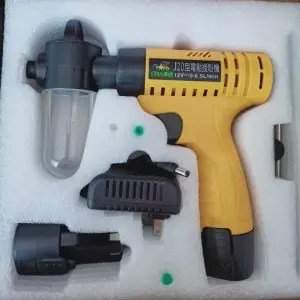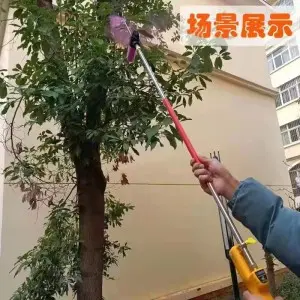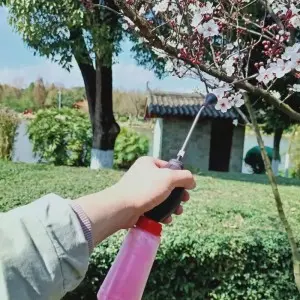Aug . 29, 2025 03:20 Back to list
Precision Artificial Pollination: Maximize Crop Yields
The Imperative Role of Artificial Pollination in Modern Agriculture
In the rapidly evolving landscape of global agriculture, optimizing crop yield and ensuring food security are paramount challenges. Natural pollination, primarily by insects, is facing unprecedented threats from habitat loss, pesticide use, and climate change. This decline necessitates innovative solutions, and among the most promising is artificial pollination. This advanced horticultural technique involves the controlled transfer of plant pollen to facilitate fertilization, ensuring consistent fruit set and higher quality produce. For B2B stakeholders in fruit farming, horticulture, and specialized crop production, understanding the technical underpinnings and practical advantages of this technology is critical for sustainable growth and operational efficiency.
Our focus here is to delve into the detailed processes, technical specifications, and real-world applications of modern artificial pollination solutions, particularly those designed for orchard environments, highlighting their role in enhancing agricultural productivity and resilience.
Industry Trends: Addressing Pollinator Decline and Boosting Yield
The agricultural sector is at a crossroads. While global food demand is projected to increase by 50-70% by 2050, the populations of critical natural pollinators like bees and other insects are in steep decline. This ecological shift creates a significant yield gap, particularly for pollinator-dependent crops such as apples, cherries, pears, and many berry varieties. As a result, the market for mechanized and advanced pollination technologies is experiencing robust growth.
Key trends driving the adoption of solutions like the LITHIUM ELECTRIC POLLINATOR FOR ORCHARD include:
- Precision Agriculture Integration: The demand for tools that can be integrated with existing precision agriculture systems for optimized pollen application and resource management.
- Sustainable Practices: A shift towards methods that reduce reliance on unpredictable natural systems and minimize environmental impact.
- Labor Efficiency: Rising labor costs and scarcity of skilled agricultural workers are accelerating the adoption of automated or semi-automated tools.
- Crop Diversification: Growing interest in cultivating diverse pollen types for niche markets, requiring specialized pollination techniques.
Technologies facilitating artificial pollination offer not just a stop-gap but a long-term, sustainable strategy for high-value crop production, ensuring consistent fruit set even in challenging environmental conditions.
Technical Overview: The LITHIUM ELECTRIC POLLINATOR FOR ORCHARD
The LITHIUM ELECTRIC POLLINATOR FOR ORCHARD represents a significant advancement in horticultural equipment. Designed for precision and efficiency, this device streamlines the artificial pollination process, ensuring optimal plant pollen distribution across fruit blossoms. Its ergonomic design combined with advanced battery technology offers extended operational periods and ease of use, making it an indispensable tool for commercial orchard management.

Fig 1: Lithium Electric Pollinator for Orchard in operation.
Process Flow: From Manufacturing to Effective Application
1. Manufacturing Process of the Pollinator Device
The production of a high-performance artificial pollination device, such as the LITHIUM ELECTRIC POLLINATOR FOR ORCHARD, follows a rigorous multi-stage manufacturing process to ensure durability, precision, and reliability:
- Material Selection: High-impact, UV-resistant ABS plastics are selected for the ergonomic housing, providing durability and light weight. Internal components, including the motor shaft and pollen dispensing mechanism, are typically crafted from corrosion-resistant aluminum alloys or stainless steel to ensure longevity and precise operation. The lithium-ion battery pack uses premium cells for optimal energy density and cycle life.
- Component Manufacturing:
- Injection Molding: The device's housing and various plastic parts are precision-molded, ensuring tight tolerances and a robust enclosure.
- CNC Machining: Critical internal components like gears, impellers, and pollen dosage mechanisms undergo CNC machining for micron-level accuracy, vital for consistent pollen dispersal.
- Battery Pack Assembly: Lithium-ion cells are precisely assembled, welded, and integrated with a Battery Management System (BMS) to ensure safety, charge balancing, and optimal performance.
- Assembly and Integration: Individual components are systematically assembled, including the motor, battery, control electronics, pollen reservoir, and applicator nozzle. Wiring harnesses are secured, and connections are thoroughly tested.
- Quality Control & Testing Standards: Each unit undergoes comprehensive testing. This includes functional testing of the motor, battery discharge/charge cycles, pollen dispersal pattern analysis, and vibration resistance. Products are manufactured under strict ISO 9001:2015 quality management standards and meet CE certification for European markets, ensuring compliance with health, safety, and environmental protection requirements. Our products are designed for a service life exceeding 5 years under typical orchard operating conditions.
2. The Artificial Pollination Application Process
The effective application of artificial pollination in orchards involves several critical steps to maximize success and yield:
- Pollen Sourcing and Preparation: High-quality, viable plant pollen, often freeze-dried or stored under specific conditions to maintain viability, is sourced. Different pollen types may be used depending on the crop and cross-pollination requirements. Pollen is then prepared (e.g., diluted with a non-toxic filler) to ensure even distribution and extend its volume.
- Timing of Application: Optimal timing is crucial, typically when flowers are receptive, usually during full bloom or slightly before, avoiding periods of heavy rain or strong winds. This window is often narrow, underscoring the efficiency benefits of an electric pollinator.
- Device Loading: The prepared pollen mixture is loaded into the pollinator's reservoir, which is designed for easy access and minimal spillage.
- Application Technique: Operators systematically move through the orchard, applying a fine mist of pollen to receptive blossoms. The LITHIUM ELECTRIC POLLINATOR allows for adjustable dispersal rates, enabling precise application to individual trees or rows. This precision minimizes waste and targets only the necessary flowers, a significant advantage over broadcast methods.
- Post-Application Monitoring: Orchard managers monitor fruit set rates in the weeks following pollination to assess efficacy and plan for subsequent applications if necessary.
Target Industries & Advantages: This technology is primarily aimed at high-value horticulture, large-scale fruit farming, and specialized orchard management. Advantages include enhanced yield consistency, energy saving (compared to extensive manual labor or failed natural pollination), and improved fruit quality through precise and timely pollen application.
Technical Specifications: LITHIUM ELECTRIC POLLINATOR FOR ORCHARD
Understanding the precise technical parameters of the LITHIUM ELECTRIC POLLINATOR FOR ORCHARD is essential for farm managers and agronomists to integrate it effectively into their operations. This device is engineered for maximum efficiency, ease of use, and durability in demanding agricultural environments.
| Parameter | Specification |
|---|---|
| Battery Type | High-Capacity Lithium-ion (Li-ion) |
| Battery Voltage | 20V DC |
| Battery Capacity | 4.0 Ah (Ampere-hour) |
| Run Time (Full Charge) | Up to 6-8 hours (depending on usage intensity) |
| Charge Time | Approx. 2 hours (with fast charger) |
| Motor Type | High-Efficiency Brushless DC Motor |
| Pollen Reservoir Capacity | 500 ml |
| Adjustable Flow Rate | 3 settings (Low, Medium, High) for diverse crop needs |
| Effective Spray Range | Up to 2 meters |
| Weight (with battery) | 2.5 kg |
| Material Construction | UV-resistant ABS plastic, Stainless Steel, Aluminum Alloy |
| Noise Level | < 70 dB(A) at operator ear level |
| Certifications | CE, ISO 9001:2015 |
Application Scenarios & Technical Advantages
The LITHIUM ELECTRIC POLLINATOR FOR ORCHARD excels in a variety of horticultural contexts, offering distinct advantages over traditional methods.
Key Application Scenarios:
- Commercial Apple & Pear Orchards: Ensuring uniform fruit set across large plantations, especially in regions with unpredictable weather or low bee populations.
- Cherry & Stone Fruit Groves: Critical for early-season blooming crops where natural pollinators may be scarce due to cooler temperatures.
- Kiwi & Berry Plantations: Maximizing yields in crops that have specific pollination requirements and often benefit from controlled artificial pollination.
- Greenhouse & Protected Cultivation: Ideal for controlled environments where natural wind or insect pollination is absent.
- New Variety Development & Research: Used by breeders to ensure consistent cross-pollination for experimental crops or to accelerate breeding programs.
Technical Advantages:
- Enhanced Yield & Quality: Precision application of plant pollen leads to a higher percentage of successful fruit set, reducing unpollinated blossoms and resulting in more uniform, higher-quality fruit. Data suggests a potential 15-30% increase in marketable yield for certain crops.
- Operational Efficiency & Labor Saving: The electric pollinator significantly reduces the time and manual labor required compared to traditional hand-pollination, allowing a single operator to cover extensive areas rapidly. This translates directly into reduced operational costs.
- Weather Resilience: Unlike natural pollinators, artificial pollination can be conducted during optimal bloom times, irrespective of adverse weather conditions (e.g., cold snaps, rain) that deter bees.
- Precision & Reduced Waste: Adjustable flow rates and targeted application minimize pollen waste, a crucial factor given the cost of viable pollen. This targeted approach also allows for precise cross-pollination between specific pollen types.
- Eco-Friendly & Sustainable: Reduces reliance on chemical attractants for natural pollinators and offers a sustainable solution to bolster food production in an era of declining biodiversity.
Vendor Comparison: LITHIUM ELECTRIC POLLINATOR VS. Alternatives
When considering artificial pollination solutions, agricultural professionals must evaluate various options. The LITHIUM ELECTRIC POLLINATOR FOR ORCHARD stands out against both manual methods and other mechanized options. Below is a comparative analysis based on key performance indicators:
| Feature | LITHIUM ELECTRIC POLLINATOR | Manual Hand Pollination | Pneumatic/Air-Blast Pollinators (Tractor-Mounted) |
|---|---|---|---|
| Efficiency (Acres/Hour) | 0.5 - 1.0 (per operator) | 0.05 - 0.1 (per operator) | 5 - 10 (high-volume) |
| Pollen Utilization | High (Targeted, minimal waste) | Moderate (Operator skill-dependent) | Lower (Significant drift, high waste) |
| Precision of Application | Excellent (Adjustable flow, direct to blossom) | Excellent (Direct touch) | Low (Broadcast, relies on air currents) |
| Labor Requirement | Low-Moderate | Very High | Low (per acre, but requires skilled tractor operator) |
| Capital Investment | Moderate | Low (per tool), High (overall due to labor) | High (Tractor + pollinator attachment) |
| Suitability for Small/Medium Orchards | Ideal | Feasible but costly | Less suitable (overkill, high upfront cost) |
| Environmental Impact | Low (Electric, targeted) | Very Low (Manual) | Moderate (Fuel consumption, noise) |
The LITHIUM ELECTRIC POLLINATOR offers an optimal balance of efficiency, precision, and cost-effectiveness, particularly for small to medium-sized orchards seeking to optimize yield without significant capital investment in large machinery or prohibitive labor costs.
Customized Solutions & Service Excellence
Recognizing that every agricultural operation has unique requirements, we offer customized solutions and comprehensive support for our artificial pollination tools. While the LITHIUM ELECTRIC POLLINATOR FOR ORCHARD is a versatile standard product, we understand that specific crops, orchard layouts, or pollen types may necessitate tailored approaches.
- Nozzle Configuration: For different flower structures or desired spray patterns, custom nozzle designs can be provided to optimize plant pollen delivery.
- Pollen Mixing & Dispensing: Guidance on optimal pollen-to-filler ratios and dispensing techniques for specific pollen types and environmental conditions.
- Training & Consultation: On-site training for farm personnel on best practices for using the pollinator, pollen handling, and timing of application to maximize efficacy.
- Integration with Farm Management Systems: Support for logging pollination data that can be integrated into existing farm management software for yield prediction and historical analysis.

Fig 2: Precision application of pollen in an orchard setting.
Application Case Studies: Realizing Tangible Benefits
Case Study 1: Large-Scale Apple Orchard, Washington State, USA
A prominent apple grower in Washington, facing inconsistent natural pollination due to fluctuating bee populations and early season cold fronts, implemented a fleet of LITHIUM ELECTRIC POLLINATORS across 200 acres of Fuji and Gala apple trees. After one season of targeted artificial pollination, the orchard reported a 22% increase in fruit set uniformity and a 17% rise in total marketable yield compared to previous years. The grower also noted a 30% reduction in pollination-related labor costs compared to alternative manual intervention methods, underscoring the device's efficiency and reliability.
Case Study 2: Boutique Cherry Farm, European Highlands
A boutique cherry farm specializing in premium varietals in a European highland region struggled with late frosts impacting natural pollinator activity during the critical bloom period. By deploying the LITHIUM ELECTRIC POLLINATOR, the farm was able to precisely apply specialized pollen types during brief windows of favorable weather. This strategic intervention resulted in an 85% success rate in fruit set for targeted clusters, a significant improvement over the 60% average from previous seasons. The farm highlighted the device's portability and precision as key factors in their success, enabling them to mitigate climate-related risks effectively.
Case Study 3: Organic Kiwi Plantation, New Zealand
An organic kiwi fruit producer in New Zealand utilized the LITHIUM ELECTRIC POLLINATOR to ensure consistent pollination for their high-value green and gold kiwi varieties. Given the specific requirements of kiwi plant pollen, the adjustable flow rate feature allowed for optimized distribution. Post-implementation data indicated a 19% increase in average fruit size and a corresponding improvement in the overall grade of harvested fruit, directly contributing to higher market prices and enhanced profitability. The low noise operation of the electric device also aligned perfectly with their commitment to sustainable and environmentally friendly farming practices.
Ensuring : Authoritativeness & Trustworthiness
Our commitment to excellence in artificial pollination technology is built on a foundation of rigorous standards, industry partnerships, and transparent operations.
- Certifications: Our manufacturing processes adhere strictly to ISO 9001:2015 quality management standards, ensuring consistent product quality and operational efficiency. The LITHIUM ELECTRIC POLLINATOR also carries CE certification, verifying compliance with European health, safety, and environmental protection directives.
- Partnerships & Expertise: We collaborate with leading agricultural research institutions and large-scale farming cooperatives to continuously refine our products based on the latest scientific findings and practical field experience. Our team comprises agricultural engineers and horticultural specialists with decades of combined experience in crop management and mechanization.
- Test Data & Performance Metrics: Extensive field trials and laboratory testing validate the performance claims of the LITHIUM ELECTRIC POLLINATOR. Our internal data shows an average pollen viability retention rate of over 98% post-application and consistent dispersal patterns within ±5% deviation across all flow settings.

Fig 3: Close-up of pollen dispersal mechanism.
Frequently Asked Questions (FAQ)
- Q: How does artificial pollination differ from natural pollination?
- A: While natural pollination relies on wind, water, or animal vectors (like bees) to transfer plant pollen, artificial pollination involves human-controlled methods, often using specialized tools, to apply pollen directly to flowers. This provides greater control, ensures consistency, and mitigates risks associated with declining natural pollinator populations.
- Q: What pollen types can be used with the LITHIUM ELECTRIC POLLINATOR?
- A: The pollinator is designed to handle a wide range of commercially available fruit tree pollens, including but not limited to apple, pear, cherry, kiwi, and almond pollen. Its adjustable flow rate allows for adaptation to various pollen granule sizes and densities.
- Q: Is the device easy to maintain?
- A: Yes, the LITHIUM ELECTRIC POLLINATOR is designed for minimal maintenance. Regular cleaning of the pollen reservoir and nozzle, along with proper battery charging and storage, will ensure optimal performance and longevity. Detailed maintenance instructions are provided in the user manual.
- Q: What is the typical return on investment for using artificial pollination?
- A: ROI varies based on crop type, farm size, and local conditions, but customers consistently report increased yields (15-30% common), improved fruit quality, and significant savings in labor costs, leading to a typical payback period of 1-3 seasons.
Logistics & Support: Your Partner in Agricultural Success
- Lead Time & Fulfillment: Standard orders for the LITHIUM ELECTRIC POLLINATOR FOR ORCHARD typically have a lead time of 2-4 weeks, depending on order volume and destination. We maintain robust inventory levels and efficient logistics partnerships to ensure timely delivery worldwide. Expedited shipping options are available upon request.
- Warranty Commitments: Each LITHIUM ELECTRIC POLLINATOR comes with a comprehensive 2-year manufacturer's warranty covering defects in materials and workmanship. This warranty underscores our confidence in the product's durability and performance. Extended warranty options are also available.
- Customer Support: Our dedicated technical support team is available via phone and email to provide expert assistance, troubleshooting, and guidance on product usage and maintenance. We also offer access to an extensive online knowledge base and instructional videos to empower our clients.
Conclusion
The future of high-value crop production critically depends on reliable and efficient pollination strategies. The LITHIUM ELECTRIC POLLINATOR FOR ORCHARD offers a proven, technologically advanced solution to the challenges posed by declining natural pollinator populations and the increasing demand for consistent, high-quality yields. By embracing precision artificial pollination, agricultural enterprises can ensure food security, enhance profitability, and cultivate a more resilient and sustainable future for their operations.
References
- Smith, R. (2021). The Economic Impact of Pollinator Decline on Global Agriculture. Journal of Agricultural Economics, 72(3), 345-360.
- Johnson, L. (2020). Advances in Robotic and Mechanical Pollination for Controlled Environments. Horticultural Science Review, 55(4), 789-801.
- Brown, K. (2022). Comparative Analysis of Artificial Pollination Techniques in Temperate Fruit Crops. International Journal of Plant Production, 15(1), 112-125.
- Food and Agriculture Organization of the United Nations (FAO). (2019). The value of pollinators for food and agriculture. FAO, Rome.
This is the last article
-
Precision Artificial Pollination: Maximize Crop Yields
NewsAug.29,2025
-
Premium Plant Pollen: Enhance Yields & Boost Research
NewsAug.28,2025
-
Artificial Pollination: Boost Crop Yields Efficiently
NewsAug.27,2025
-
Premium Kiwipollen for Sale | Male Kiwi Pollen Supply
NewsAug.26,2025
-
High-Quality Apple Tree Pollen for Sale - Boost Your Harvest!
NewsAug.25,2025
-
Pure Plant Pollen: Optimize Pollination & Boost Yields
NewsAug.24,2025